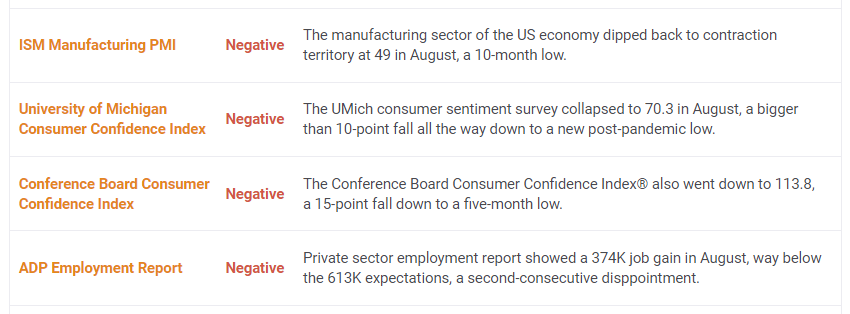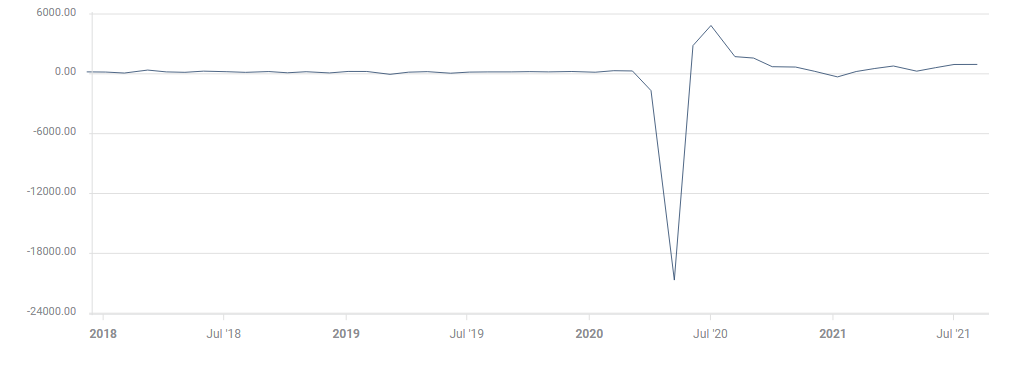- Weak leading indicators have significantly depressed expectations for August's Nonfarm Payrolls.
- There are reasons to expect a somewhat better outcome.
- The low bar is easier to cross, and overstretched shorts imply a big dollar bounce.
The dollar is data-dependent – and that data has been downbeat, sending the dollar down. Has it gone too far? The most significant statistic for the Federal Reserve's critical September decision is August's Nonfarm Payrolls, and a mix of exaggerated low expectations and overstretched dollar shorts could trigger a big bounce.
Fed Chair Jerome Powell refrained from committing himself to tapering the bank's gargantuan $120 billion/month bond-buying scheme in the upcoming September meeting. His caution – coming despite two excellent leaps in the past two labor market reports.
However, a third consecutive blockbuster NFP could tilt the picture toward kickstarting tapering – or at least making a pre-announcement – in less than weeks. Powell left it up to the NFP, but data coming out ahead of the report looked awful and dealt the dollar another blow.
Red on the screens
Source: FXStreet
First came the Conference Board's Consumer Confidence gauge for August which tumbled to 113.8 points, far worse than expected. It confirmed a similar fall from the University of Michigan that had already been published before Powell's speech. The weaker sentiment means less consumption and fewer jobs.
Then came ADP's disheartening private-sector jobs report, which showed an increase of only 374,000 positions last month versus estimates of over 600,000. The third blow came shortly afterward from the ISM Manufacturing Purchasing Managers' Index. While the headline beat estimates, the employment component contracted.
This toxic trio sent Nonfarm Payrolls expectations down, and with them the dollar. The economic calendar is pointing to an increase of 750,000 jobs in August, but economists were surveyed before the recent developments and real market expectations – aka "the whisper number" is probably significantly lower. An increase of 500,000 could be the new estimate.
Reasons to expect a better figure
There are counter-arguments to interpret these three downbeat figures. First, consumer confidence statistics are only "soft data" – a survey. They do not necessarily reflect actual consumption and "hard data" can prove otherwise. While retail sales data disappointed in July, Durable Goods Orders beat estimates.
Regarding ADP, America's largest payroll company's figures were out of sync with official Nonfarm Payrolls reports since the pandemic broke out. The company managers around a fifth of all American salaries – a considerable amount, but one that has its limits. The unpredictable nature of the pandemic and the weak correlation between ADP data and the NFP has led some economists to dismiss the company's report. Why should it be different now?
While the ISM surveys' data is more reliable than consumer polls, it is essential to note that the number that knocked down estimates is only for the small manufacturing sector. The heavyweight services sector – responsible for over two-thirds of employment – is released this time only after the NFP. Therefore, the manufacturing PMI had an outsized impact – but not necessarily a justified one.
Overall, the data could be painting a gloomy picture, perhaps too gloomy. Surprises in this all-important jobs report are even more common in the covid era.
Source: FXStreet
Nevertheless, even if Nonfarm Payrolls print a poor number, the dollar seems too pressed to the ropes – and it could be ready to spring back.
GBP/USD is up some 200 pips off the lows and EUR/USD has risen for five consecutive days. They are both due for a correction and so are commodity currencies, which forgot about the previous gloom.
Conclusion
August's NFP is critical due to the open question of Fed tapering. Real estimates are considerably low due to weak leading indicators, and the dollar has already paid the price. A "not that bad" report could trigger a substantial greenback comeback.
More US August Nonfarm Payrolls Preview: Analyzing major pairs' reaction to NFP surprises
Information on these pages contains forward-looking statements that involve risks and uncertainties. Markets and instruments profiled on this page are for informational purposes only and should not in any way come across as a recommendation to buy or sell in these assets. You should do your own thorough research before making any investment decisions. FXStreet does not in any way guarantee that this information is free from mistakes, errors, or material misstatements. It also does not guarantee that this information is of a timely nature. Investing in Open Markets involves a great deal of risk, including the loss of all or a portion of your investment, as well as emotional distress. All risks, losses and costs associated with investing, including total loss of principal, are your responsibility. The views and opinions expressed in this article are those of the authors and do not necessarily reflect the official policy or position of FXStreet nor its advertisers. The author will not be held responsible for information that is found at the end of links posted on this page.
If not otherwise explicitly mentioned in the body of the article, at the time of writing, the author has no position in any stock mentioned in this article and no business relationship with any company mentioned. The author has not received compensation for writing this article, other than from FXStreet.
FXStreet and the author do not provide personalized recommendations. The author makes no representations as to the accuracy, completeness, or suitability of this information. FXStreet and the author will not be liable for any errors, omissions or any losses, injuries or damages arising from this information and its display or use. Errors and omissions excepted.
The author and FXStreet are not registered investment advisors and nothing in this article is intended to be investment advice.
Recommended Content
Editors’ Picks

EUR/USD stays defensive near 1.1350 as US Dollar looks to stabilize
EUR/USD remains on the back foot for the second consecutive session, trading near 1.1350 in the European trading hours on Tuesday. The pair weakens as the US Dollar attempts to regain stability amid the US-China trade war and growing concerns over US recession. German/ EU data are awaited.

GBP/USD battles 1.3200 after UK jobs data
GBP/USD is defending minor bids near the 1.3200 mark in the early European session on Tuesday. The latest data from the UK showed that Unemployment Rate steadied at 4% in the quarter to February while Average Earnings disappointed, weighing negatively on the Pound Sterling.

Gold price retains its positive bias above $3,200 amid US-China trade war, bearish USD
Gold price regains positive traction as US tariff uncertainty continues to underpin safe-haven assets. Bets for aggressive Fed rate cuts in 2025 keep the USD depressed and also benefit the XAU/USD pair.

XRP resilient amid looming ETF deadlines
Ripple (XRP) flaunted a bullish outlook, trading at $2.1505 at the time of writing on Tuesday. Investor risk appetite has continued to grow since the middle of last week, propping XRP for a sustainable upward move, eyeing $3.0000 psychological level.

Is a recession looming?
Wall Street skyrockets after Trump announces tariff delay. But gains remain limited as Trade War with China continues. Recession odds have eased, but investors remain fearful. The worst may not be over, deeper market wounds still possible.

The Best brokers to trade EUR/USD
SPONSORED Discover the top brokers for trading EUR/USD in 2025. Our list features brokers with competitive spreads, fast execution, and powerful platforms. Whether you're a beginner or an expert, find the right partner to navigate the dynamic Forex market.

